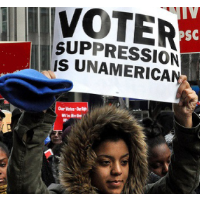3 California Counties that Ran Afoul of Voting Rights Act Freed by High Court Ruling
 Voting Rights Act supporters demonstrate.
Voting Rights Act supporters demonstrate.
Three California counties will test the suggestion—by U.S. Supreme Court Chief Justice John Roberts in his majority opinion—that a key provision of the landmark 1965 Voting Rights Act (VRA), which required states and localities not to suppress voting rights, had outlived its usefulness.
The counties of Monterey, Yuba and Kings will no longer have to get pre-clearance from the federal government to change their election rules, despite a history of discrimination against Latinos and Asians. The high court’s 5-4 ruling Monday ends use of a formula Congress prescribed for determining where discrimination was occurring.
The conservative court, which professes to abhor activist judicial behavior, voted to junk high-profile congressional legislation that has had overwhelming support for decades—it was re-authorized in 2006 with a Senate vote of 98-0. Instead, the court recommended that a divided Congress with little hope of consensus come up with a new standard, while nine states (mostly in the South) and a number of localities reclaim their lost privileges.
It is conceivable that California could expand its own voting rights law to pick up some of the slack and address some of the issues that landed four California counties on the list in the 1970s. (Merced County got off the list in 2012.) Monterey County was added after using a literacy test and having lousy turnout numbers. Yuba County had English-only ballots.
But one of the reasons Congress used general measures of voter participation rather than specific discriminatory practices as triggers for applying the voting act is the difficulty in predicting what new and innovative schemes might be devised. Current popular practices include: reducing polling places in minority neighborhoods; requiring citizens without driver’s licenses to have photo IDs; polling-place intimidation; instituting at-large voting instead of districts; making registration more onerous; and kicking people off registration rolls for spurious reasons.
All four California counties were sparsely populated rural areas with large minority populations. They also had military installations, prompting officials there to blame transient servicemen for the low voter turnout that helped get them in trouble.
A 2009 study (pdf) at Stanford University didn’t support that assertion. It found that voter registration and turnout increased by 6.2% and 5.0%, respectively, in the counties after implementation of the Voting Rights Act. Furthermore, the author, Jessica Lee, said the law’s effect increased over time. By 2000, registration was up 12.5% and turnout rose 12.1%.
“Because voter registration and turnout rates in Section 5 counties are already lower than the California average, the removal of Section 5 protections may only further depress those rates, thus widening the gap between Section 5 counties and the rest of the state,” Lee wrote.
That’s a proposition that is sure to be tested over the next few years.
–Ken Broder
To Learn More:
The Effects of Section 5 of the Voting Rights Act: A California Case Study (by Jessica Lee, Public Policy Program at Stanford University) (pdf)
Voting Rights Act Provision Ruled Unconstitutional (by Gary Martin, San Francisco Chronicle)
3 California Counties Affected by Supreme Court Decision on Voting (by Maura Dolan, Los Angeles Times)
Why the Voting Rights Act of 1965 Plays a Role in California Redistricting (Redistricting California)
Supreme Court Voting Rights Decision Simplified—A Republican Dream Come True (by David Wallechinsky, AllGov)
- Top Stories
- Controversies
- Where is the Money Going?
- California and the Nation
- Appointments and Resignations
- Unusual News
- Latest News
- California Forbids U.S. Immigration Agents from Pretending to be Police
- California Lawmakers Urged to Strip “Self-Dealing” Tax Board of Its Duties
- Big Oil’s Grip on California
- Santa Cruz Police See Homeland Security Betrayal in Use of Gang Roundup as Cover for Immigration Raid
- Oil Companies Face Deadline to Stop Polluting California Groundwater





